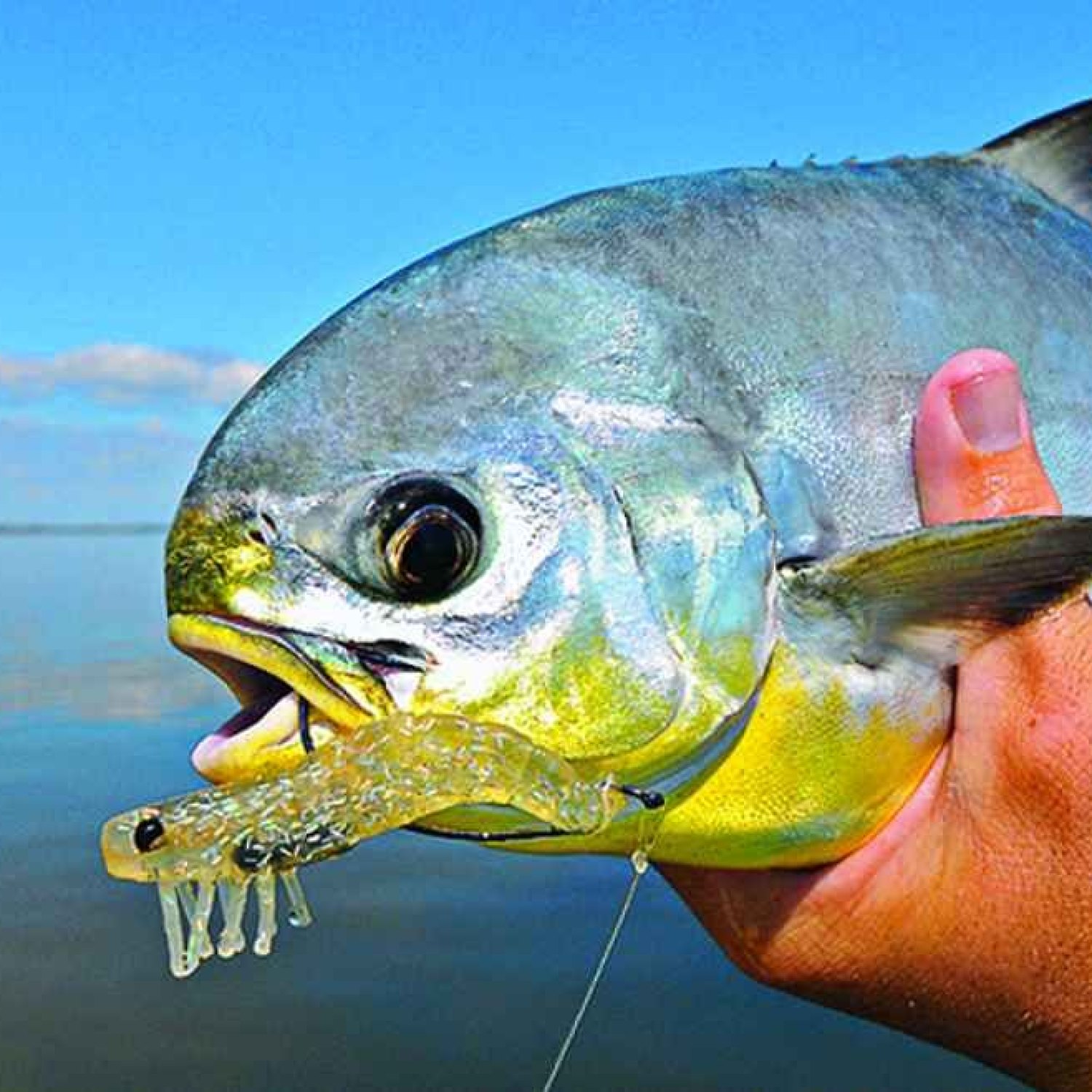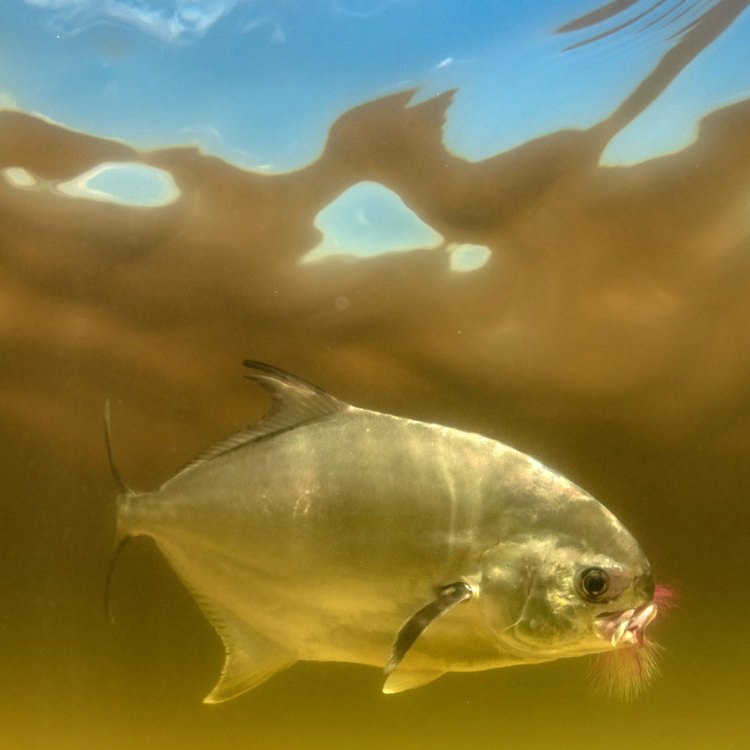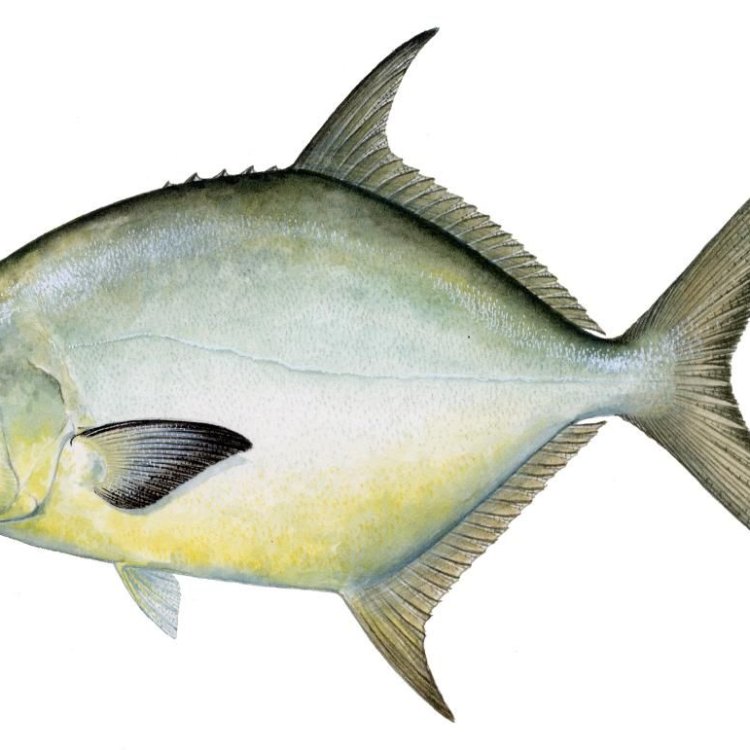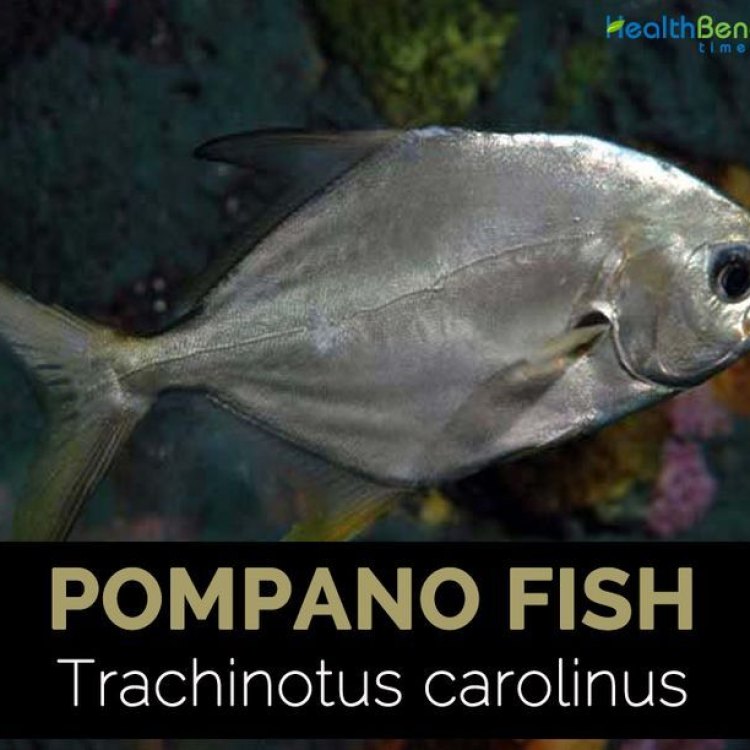
Pompano Fish
Average length: 18 inches (46 cm), can grow up to 24 inches (61 cm)
The Pompano Fish, known for its tall and compressed body shape, can be found along the Atlantic coast from Massachusetts to Florida and in the Gulf of Mexico. With an average length of 18 inches, these fish can grow up to 24 inches. Belonging to the Carangidae family, they are popular for their delicious white flesh and are a great catch for recreational anglers. #PompanoFish #AtlanticCoast #GulfOfMexico #Carangidae #RecreationalFishing
Animal Details Summary:
Common Name: Pompano Fish
Kingdom: Animalia
Habitat: Coastal waters and offshore reefs
The Fascinating World of Pompano Fish
The ocean is a vast and mysterious place, filled with all sorts of creatures that continue to amaze and captivate us. One such creature is the Pompano fish, also known as Trachinotus carolinus in the scientific community. Its common name, Pompano fish, is derived from a French word "papillon," which means butterfly, because of its resemblance to the shape of a butterfly.But there is so much more to these fish than just their name Pompano Fish. From their unique physical features to their feeding habits and geographical distribution, Pompano fish are truly fascinating creatures that deserve to be explored further. So, let's dive into the world of Pompano fish and discover what makes them so unique and special.
Before we dive into the specifics of Pompano fish, let's first understand their place in the animal kingdom. Pompano fish belong to the kingdom Animalia, phylum Chordata, and class Actinopterygii. These fish are classified under the order Perciformes and the family Carangidae, a group that includes other popular game fish such as amberjacks and jacks.
Pompano fish are found in coastal waters and offshore reefs, specifically in the Atlantic Ocean. They are native to the United States, with their primary habitat being along the Atlantic coast from Massachusetts to Florida, and also in the Gulf of Mexico. These fish are highly sought after by recreational and commercial fishermen, making them an essential part of the ecosystem and the fishing industry.
Now, let's take a closer look at the unique characteristics of Pompano fish Purple Emperor Butterfly.
Physical Features
Pompano fish have a distinct physical appearance that sets them apart from other fish species. They have a tall, deeply compressed body that is laterally compressed, giving them a rather flat appearance. This body shape allows them to cruise through the water quickly, making them adept at hunting their prey.One of the most distinguishing features of Pompano fish is their coloration. They have a silver or bluish-green color on their back and sides, while their belly is silver or yellowish-white. This coloration allows them to blend in with their surroundings, making them difficult to spot by predators, and also helps them ambush their prey.
Another unique physical feature of Pompano fish is their forked caudal fin, which is similar to the shape of a crescent moon. This fin not only adds to their graceful appearance but also provides them with powerful propulsion, enabling them to swim at high speeds.
Habitat and Distribution
As mentioned earlier, Pompano fish are found in coastal waters and offshore reefs, specifically in the Atlantic Ocean. These fish are generally found in warmer waters, with temperatures ranging from 68°F to 85°F. They prefer areas with sandy bottoms, where they can easily camouflage themselves while waiting for their prey.Pompano fish have a wide geographical distribution, as they can be found along the eastern coast of the United States, from Massachusetts to Florida, and also in the Gulf of Mexico. They can also be found in other parts of the world, such as the Caribbean, Brazil, and West Africa, although they are not as abundant in these areas as they are in the Atlantic.
Feeding Behavior
Pompano fish are omnivores, meaning they eat both plant and animal matter. Their diet primarily consists of small fish, crustaceans, and mollusks, as well as algae and other aquatic plants. They use their sharp teeth to break down their food, and their strong jaws to crush shells and other hard substances.Despite being hunter-gatherers, Pompano fish do not aggressively hunt for their prey. Instead, they use their excellent camouflage skills to sneak up on their prey and catch them by surprise. This behavior also helps them avoid larger predators, such as sharks and barracudas, that may see them as a tasty meal.
Size and Growth
On average, Pompano fish grow to a length of 18 inches (46 cm), but they can reach up to 24 inches (61 cm). They are fast-growing fish, and within their first year, they can reach a length of around 12 inches (30 cm).Their rapid growth rate makes them a popular target for fishermen. As a result, strict regulations and size limits have been put in place to protect the Pompano fish population. These regulations have helped maintain a healthy population of these fish, making them a sustainable and valuable resource for both recreational and commercial fishing industries.
Culinary Delicacy
Aside from being a popular game fish, Pompano fish are also highly prized for their delicious, white, flaky meat. They are considered a delicacy in many coastal regions, and their meat is often compared to that of red snapper or sea bass.Their unique flavor and texture make them a favorite among seafood enthusiasts, and they are featured in many high-end restaurants. Despite their popularity, Pompano fish are not easy to come by in some regions, as they are a seasonal catch and can quickly sell out.
Final Thoughts
Pompano fish are truly fascinating creatures with unique physical features, a wide geographical distribution, and a valuable place in the ecosystem. They have captivated fishermen and seafood enthusiasts alike, and their delicious meat has become a sought-after delicacy.However, with increasing demands and changing environmental conditions, it is crucial to ensure the sustainability of the Pompano fish population. Only by implementing responsible fishing practices, protective legislations, and creating awareness about the importance of these fish can we ensure their survival in the years to come.
So, let's continue to marvel at the wonders of the ocean, including the beautiful and distinct Pompano fish, and strive towards protecting and preserving them for generations to come.

Pompano Fish
Animal Details Pompano Fish - Scientific Name: Trachinotus carolinus
- Category: Animals P
- Scientific Name: Trachinotus carolinus
- Common Name: Pompano Fish
- Kingdom: Animalia
- Phylum: Chordata
- Class: Actinopterygii
- Order: Perciformes
- Family: Carangidae
- Habitat: Coastal waters and offshore reefs
- Feeding Method: Omnivorous
- Geographical Distribution: Atlantic Ocean
- Country of Origin: United States
- Location: Along the Atlantic coast from Massachusetts to Florida, and also in the Gulf of Mexico
- Animal Coloration: Silver or bluish-green on the back and sides, with a silver or yellowish-white belly
- Body Shape: Tall and deeply compressed
- Length: Average length: 18 inches (46 cm), can grow up to 24 inches (61 cm)

Pompano Fish
- Adult Size: Average weight: 3-4 pounds (1.4-1.8 kg), can reach up to 30 pounds (13.6 kg)
- Average Lifespan: 5-8 years
- Reproduction: Sexual
- Reproductive Behavior: Spawning occurs offshore in large groups
- Sound or Call: None
- Migration Pattern: Seasonal migration patterns along the coast
- Social Groups: Generally solitary or in small groups
- Behavior: Active and fast swimmers, often seen cruising near the water surface
- Threats: Overfishing, habitat degradation
- Conservation Status: Not listed as endangered or threatened
- Impact on Ecosystem: Important prey species for larger predators
- Human Use: Highly valued for sport fishing and commercial fishing
- Distinctive Features: Prominent forked tail, small mouth, and a series of short spines on the front of the first dorsal fin
- Interesting Facts: Pompano fish are known for their delicious, tender meat and are often sought after by anglers and gourmets
- Predator: Sharks, larger predatory fish

Trachinotus carolinus
The Exquisite Pomp of the Pompano Fish
When it comes to the ocean's bounty, there is no shortage of unique and fascinating species. One such fish that stands out from the rest is the Pompano fish. With its delicate, flavorful meat and distinctive appearance, the Pompano fish has captured the hearts (and stomachs) of many anglers and gourmets alike.The Pompano fish (Trachinotus carolinus) is a member of the jack family and is commonly found in the coastal waters of the Atlantic Ocean, from Massachusetts to Brazil PeaceOfAnimals.Com. It is also found in parts of the Gulf of Mexico and the Caribbean Sea. These fish can be identified by their prominent forked tail, small mouth, and a series of short spines on the front of the first dorsal fin.
But what makes the Pompano fish so unique? In this article, we will dive into the world of this magnificent fish, exploring its physical features, behaviors, threats, human use, and more.
Physical Features
The Pompano fish may not be the largest of its kind, but it certainly stands out with its slender, elongated body and striking silver color. These fish typically reach an average size of 3-4 pounds (1.4-1.8 kg) and can grow up to 30 pounds (13.6 kg). However, larger specimens have been caught in the past, with some exceeding 44 pounds (20 kg) Perro De Presa Canario.
As mentioned earlier, the Pompano fish can be identified by its forked tail. This unique feature allows it to swim at high speeds, making it an active and fast swimmer. In fact, they are often seen cruising near the water surface in search of food, which primarily consists of small crustaceans and mollusks.
Another distinctive feature of the Pompano fish is its small mouth. This may seem like a disadvantage, but it actually helps them navigate through sandy bottoms in search of food. They use their small, pointed mouth to sift through the sand and extract their prey.
Behaviors and Reproduction
The Pompano fish is a sexually reproductive species, with spawning occurring offshore in large groups during the summer months. During this time, the males will produce a pheromone that attracts the females to a specific location. Once the females arrive, they release their eggs into the water, and the males fertilize them externally.
Once the eggs are fertilized, they will float to the surface and hatch within a day or two. The newly hatched larvae will then develop for several weeks before settling to the bottom and maturing into adults.
In terms of behavior, Pompano fish are generally solitary or found in small groups. However, during spawning season, they will join together in large groups. They are active and fast swimmers, which is why they are often spotted near the water surface. Their swift movements also help them evade predators.
Threats and Conservation Status
The Pompano fish faces several threats in the wild, with overfishing and habitat degradation being the top concerns. Due to their delicious meat, they are highly valued for both sport and commercial fishing. This has led to significant declines in their population in some regions.
Furthermore, their habitat is being degraded and destroyed due to human activities such as coastal development, pollution, and climate change. These factors have made the Pompano fish vulnerable to extinction in certain areas.
Despite these threats, the Pompano fish is not currently listed as endangered or threatened on the IUCN Red List. However, it is important to monitor their population and implement conservation measures to ensure their survival for future generations.
Impact on Ecosystem
Like all living creatures, the Pompano fish plays a vital role in its ecosystem. As a predator, it feeds on small crustaceans and mollusks, keeping their populations in check. In turn, they serve as an important prey species for larger predators such as sharks and other predatory fish.
Their presence also helps maintain a balance in the food chain, ensuring the stability of the marine ecosystem. Therefore, it is crucial to protect and conserve the Pompano fish to maintain a healthy and thriving ocean.
Human Use
The Pompano fish has been highly valued by humans for centuries, dating back to ancient civilizations like the Mayans and Aztecs. Today, it is a popular target for both sport and commercial fishing, with a high demand for its delicious and tender meat.
In addition to being a popular food fish, the Pompano fish is also highly sought after by anglers for its feisty and exciting fight. They are known for their strength and acrobatic abilities, making them a rewarding catch for any angler.
Interesting Facts
Aside from being a highly prized fish, the Pompano fish also boasts some interesting facts. Did you know that the name "pompano" is derived from the French word "pompanette," which means small fish? It is also known by other names including "Florida pompano" and "carolina," depending on the region.
Moreover, Pompano fish are known for their excellent taste, earning them the nickname "the aristocrat of the sea." Their delicate, tender meat has a rich, buttery flavor that is highly prized by gourmets and considered a delicacy in many cultures.
Predators
Despite their fast swimming abilities, Pompano fish still have a few predators to worry about. These include larger predatory fish such as barracudas, snappers, and groupers. Additionally, they are also preyed upon by sharks, which are always on the lookout for a tasty meal.
The Final Verdict
In conclusion, the Pompano fish may not be the largest or most well-known fish in the ocean, but it certainly has its unique qualities that make it stand out. From its delicate meat to its forked tail and small mouth, this fish has captured the attention of many and continues to be a highly sought after species.
However, with its vulnerable status in certain regions, it is important for us to protect and conserve the Pompano fish for future generations to enjoy. By implementing sustainable fishing practices and protecting their habitats, we can ensure that this exquisite fish continues to thrive in our oceans.

The Fascinating World of Pompano Fish
Disclaimer: The content provided is for informational purposes only. We cannot guarantee the accuracy of the information on this page 100%. All information provided here may change without prior notice.












